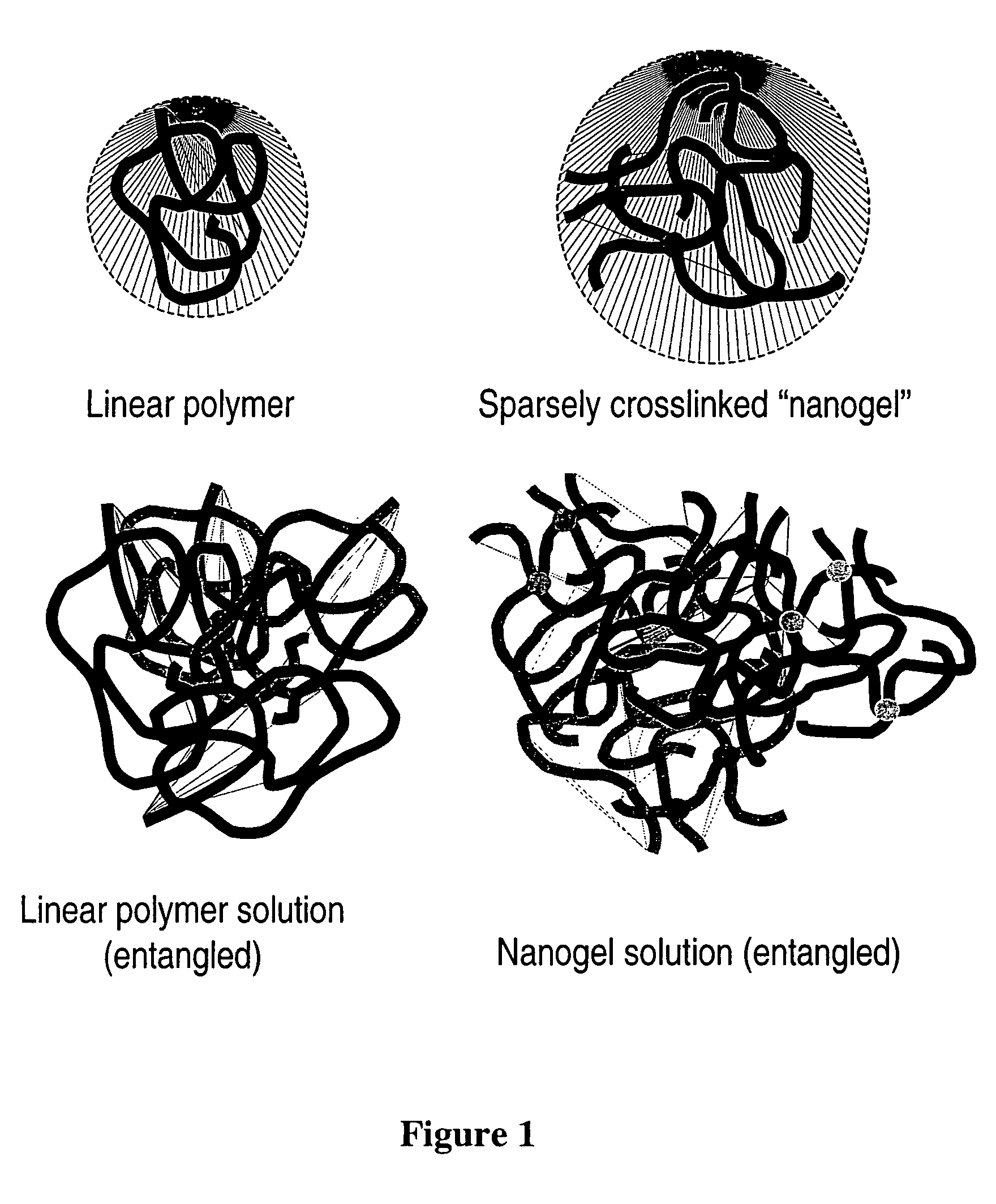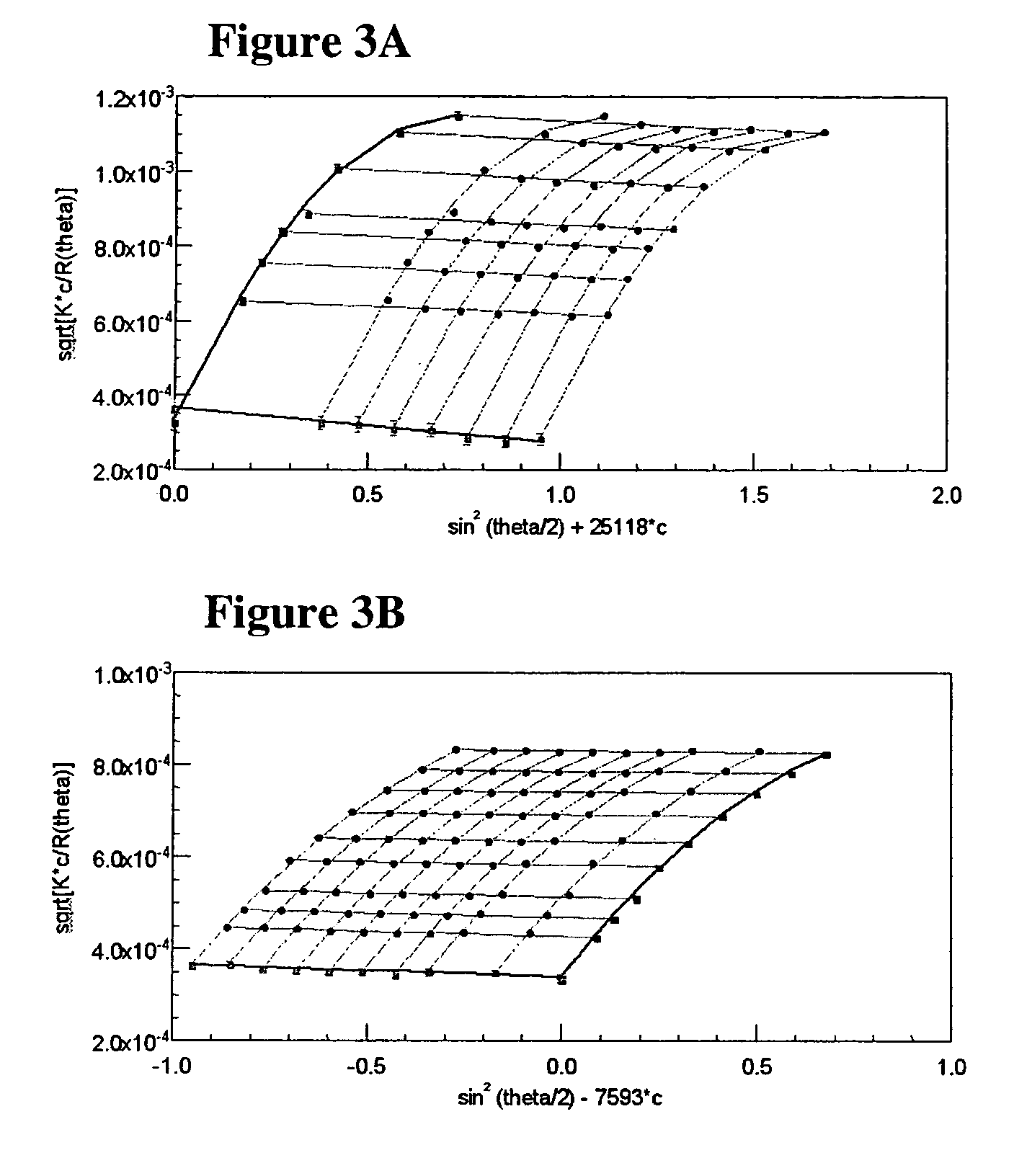Sparsely cross-linked nanogels: a novel polymer structure for microchannel DNA sequencing
a nanogel and polymer structure technology, applied in the direction of fluid pressure measurement, peptides, liquid/fluent solid measurement, etc., can solve the problems of ineffective direct transfer of slab gel technology to micron-sized channels typical of fused-silica capillaries, time and labor-intensive process of obtaining long dna sequencing reads using ultra-thin slab gels, etc., to achieve high viscosity
- Summary
- Abstract
- Description
- Claims
- Application Information
AI Technical Summary
Benefits of technology
Problems solved by technology
Method used
Image
Examples
example 1
Reagents
[0078]Tris(hydroxymethyl)aminomethane (Tris), ethylenediaminetetraacetic acid (EDTA), ultrapure grade N,N,N′,N′-tetraethylmethylenediamine (TEMED), ultrapure acrylamide, methylene bisacrylamide (Bis), and ammonium persulfate (APS) were purchased from Amresco (Solon, Ohio). N-[Tris(hydroxymethyl) methyl]-3-aminopropanesulfonic acid (TAPS) was obtained from Sigma (St. Louis, Mo.). Sorbitan monooleate (Span 80) was obtained from Fluka Chemical (St. Louis, Mo.). Isopar M (a C12-C14 isoparaffinic mixture) was obtained from Exxon (Houston, Tex.). MegaBACE Sequencing Standards (Amersham Pharmacia Biotech, Piscataway, N.J.) consisting of M13 DNA sequencing reaction products, labeled with energy-transfer dye primers and purified by standard ethanol precipitation by the manufacturer, were used without further purification. Beckman LongRead matrix was provided by Amersham Pharmacia Biotech.
example 2
Polymeric Nanogel Synthesis
[0079]Structures of acrylamide and N-methylene bisacrylamide are shown in FIG. 2. Sparsely cross-linked nanogels were produced via inverse emulsion polymerization according to a protocol described in a previous report (see, e.g., Doherty, E. A. S., et al. 2003 Electrophoresis 24: 4170-4180; herein incorporated by reference in its entirety). The emulsion was formed as follows: A mixture of 40.53 g of Isopar M and 2.47 g of Span 80 was mixed briefly before being poured into the reaction vessel, a 500-mL water-jacketed reaction flask with a four-neck top (Kontes, Vineland, N.J.). The organic phase was immediately mixed by a high-torque overhead stirrer (Caframo Limited, Wiarton, Ontario, Canada) equipped with a homemade stainless steel shaft and a four-blade pitched-blade impeller, set at 600 rpm. The organic phase was degassed for 30 min using prepurified nitrogen (Air Products, Naperville, Ill.) that was further purified using an in-line oxygen / water vapor ...
example 3
Multi-Angle Light Scattering (MALLS) for Nanogel and Linear Polymer Characterization
[0083]Weight-average molar mass and radius of gyration of high molar mass polymer samples was determined by batch MALLS using a DAWN DSP Laser Photometer-Optilab DSP Interferometric Refractometer system (both, Wyatt Technology, Santa Barbara, Calif., USA) (see, e.g., Albarghouthi, M. N., et al. Electrophoresis 2002, 23 (10), 1429-1440; herein incorporated by reference in its entirety). Stock solutions of each polymer sample were prepared at concentrations of 1×10−6 to 1×10−4 g / mL (accurately determined to three significant figures) in 18.0-MΩ purified water from a Barnstead E-Pure system (Fisher Scientific, Glenlake, Ill., USA), where the deionized water used to dissolve the polymers was first passed through 0.02-μm filters (Whatman, Maidstone, England) to remove particulates. Polymer stock solutions were mixed by slow rotation on a Roto-Torque mixer (Cole-Parmer, Vernon Hills, Ill., USA) for at leas...
PUM
| Property | Measurement | Unit |
|---|---|---|
| molar mass | aaaaa | aaaaa |
| molar mass | aaaaa | aaaaa |
| molar mass | aaaaa | aaaaa |
Abstract
Description
Claims
Application Information
 Login to View More
Login to View More - R&D
- Intellectual Property
- Life Sciences
- Materials
- Tech Scout
- Unparalleled Data Quality
- Higher Quality Content
- 60% Fewer Hallucinations
Browse by: Latest US Patents, China's latest patents, Technical Efficacy Thesaurus, Application Domain, Technology Topic, Popular Technical Reports.
© 2025 PatSnap. All rights reserved.Legal|Privacy policy|Modern Slavery Act Transparency Statement|Sitemap|About US| Contact US: help@patsnap.com



